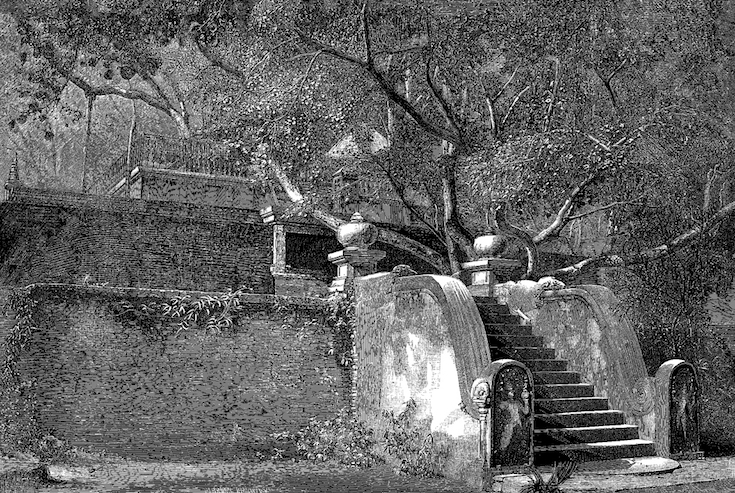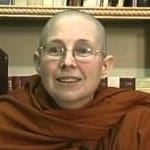On the island of Sri Lanka, during the third century BCE, a junior queen, a sister-in-law to King Devanampiya Tissa, dwelled in royal comfort. Known as Anula Devi, or Queen Anula, she was to become the first Sri Lankan woman to ordain as a Buddhist nun, or bhikkhuni.
Her story is generally traced back to an encounter the king had when hunting on a mountain one day. While in pursuit of a deer, the king suddenly came upon a dignified man with a shaven head, wearing saffron robes, who had mysteriously appeared on the mountain along with several others like him.
His name was Ven. Arahant Mahinda; he was a bhikkhu and former prince sent from India by his father, the great Emperor Ashoka, to introduce Buddhism to the people of Sri Lanka. Deeply impressed by the wise bhikkhu, the king and his large entourage took refuge in the Buddha, and then invited the venerable elders to take their meal at the palace in the morning.
After tasting the sublime joy of nibbana, the queen and the women of the palace bravely requested ordination.
Hearing the king’s praises of the bhikkhus, Anula Devi and the women of the palace were anxious to receive the teachings. After the bhikkhus took their meal, Anula Devi and the palace women offered gifts and then respectfully listened to a discourse, at the end of which it is said all them attained the first stage of enlightenment. The next morning, Arahant Mahinda gave another teaching during which Anula Devi and the women of the palace attained the second stage of enlightenment.
After tasting the sublime joy of nibbana, the queen and the women of the palace bravely requested ordination, and the king urged Mahinda to grant their wish. According to the ancient chronicle, the Mahawansa, Mahinda replied:
It is not allowed to us, O great king, to bestow ordination on women. But in [India] there lives a bhikkhuni, my younger sister,… Sanghamitta. She, who is ripe in experience, shall come hither bringing with her the southern branch of the great Bodhi-tree of the [Buddha]… and also bhikkhunis renowned; to this end send a message to the king, my father… [Sanghamitta] will confer the ordination upon these women.
So the king sent a messenger to the court of Emperor Ashoka to request that Ven. Arahant Sanghamitta come with an entourage of bhikkhunis and a cutting of the Lord Buddha’s bodhi tree. Sanghamitta’s father, the emperor, protested, knowing that she would never return. However, having heard that the queen “lives longing for ordination,” Sanghamitta was determined to respond to her plea and those of the other women, who, for the sake of liberation, wished to join the holy life.
Months passed while all necessary arrangements ensued in India. Meanwhile, in Sri Lanka, the new religion spread quickly, and soon thirty thousand Sri Lankan men had ordained. Queen Anula and the women of the palace, though living a life of luxury that most would envy, felt unable to wait for their freedom. They undertook ten precepts (novice vows) and put on the yellow robes. They then moved into a new monastic residence provided by the king, called the Lay Women’s Monastery (Upasikaa Vihara).
Finally, Sanghamitta and her bhikkhuni companions arrived by ship, carrying with them the sacred bodhi-tree cutting. Their ship entered the northern port of Jaffna, where the king honored their arrival by wading into the water in greeting. After their arrival, under Sanghamitta’s direction, the ship was broken into pieces, and the mast, rudder, and helm housed in Upasikaa Vihara and kept for public viewing (creating the world’s first museum). The bodhi-tree cutting that she brought, a living link to the enlightenment of the Buddha, was taken with great pomp to the heart of the capital city of Anuradhapura and ceremonially planted. There the blessed tree, continuously worshipped, lives on even now, 2,300 years later.
All Mahayana bhikkhunis today trace their roots back to Sanghamitta and the women she ordained in Sri Lanka.
We can only imagine Anula Devi’s delight on seeing the face of her benefactor and finally bowing to a woman in robes. Anula and the other women of the palace received the going-forth ordination from Sanghamitta, at which time Ven. Anula attained full enlightenment. The bhikkhuni sangha flourished, and less than two hundred years later, an important ceremony is said to have drawn ninety thousand bhikkhunis. Five hundred years after that, a group of bhikkhunis made the arduous voyage from Sri Lanka to China in response to the plea of Chinese women wishing to ordain, and the bhikkhuni sangha spread from there. All Mahayana bhikkhunis today trace their roots back to Sanghamitta and the women she ordained in Sri Lanka.
Thanks to an archeological find made several years ago, one can visit the place where Queen Anula and the other women fulfilled their dream. Several miles from the town of Mihintale, in a deserted area of scrub trees and stones, is a clearing made by a large slab of rock, on which is inscribed, in ancient Sinhala script: “This is the place the five hundred ladies with Queen Anula became bhikkhunis.” It is a dry windswept place, where large hand-chiseled boulders that once supported the living quarters of enlightened bhikkhunis now rest, strewn at various angles, upon the rock. What appears to be a small hill covered in brush is actually a crumbling stupa, thought to encase the bodily relics of Ven. Anula.
Today, bhikkhunis who resonate with Anula Devi’s longing for the holy life can be grateful not only to their great foremother Ven. Sanghamitta, but also to the renunciate Anula Devi, for whose sake the holy life became possible for many hundreds of thousands of women.
This is part of a Fall 2007 Buddhadharma collection of essays, stories, and poems that highlight the lives of Buddhism’s women ancestors. Read more:
- The life of Miaozong, a laywoman turned Chan abbess
- The life of Yeshe Tsogyal, Padmasambhava’s foremost disciple and consort
- The life of Otagaki Rengetsu, a Zen nun, artist, and poet


